My.Family - Ancestors, Descendants and Others
Person Page 1
Linda Sargent





 1
1
- Sargent Lineage: Richard10, Richard9, George8, Joseph7, Joseph6, Joseph5, Joseph4, Joseph3, Joseph2, John1, William0
Parents
- Father: Richard Collier Sargent, Jr (b. 5 April 1914, d. 17 April 1985)
- Mother: Barbara Lois Male (b. 21 August 1920, d. 3 March 2009)
Family: Constantine Alexander
Other Information
-
Relationship:
10th cousin 2 times removed of Kyle Lawrence Mueller
15th cousin 1 time removed of Casey Saunders Bivens
1st cousin of Julianne Stoughton - Charts/Lists: Aaron Burr, related to the Sargents, Amelia Earhart and Sophie, Charlemagne and Sargents, Charles Ives and Linda, Clara Barton and Linda, Cole Porter - a Kingsbury, Descendant Chart for Elizabeth Alsop, Descendant Chart for Griffith Bowen, Descendant Chart for Thomas Trowbridge (#1), Descendant Chart for Thomas Trowbridge (#2), Descendants of JBS, Descendants of JBS (with spouses), Descendants of Nathaniel Foote and Elizabeth Deming, Descendants of Sarah Talcott & William Wadsworth, Descendants of William Sargent, Immigrant, Descent from Henry Kingsbury, Eleanor of Aquitaine and LSR, Emily Dickinson and the Kingsburys, Forbes Family, Genealogists, Gilbert Clifford Noble and Linda, Henry Luce and Linda, Jodie Foster and Sophie, Joseph Smith and Linda, Katherine Hepburn and Linda Sargent, Kingsbury Family, Kyle and Lisa (husband and wife) are related!, Louisa May Alcott and the Kingsbury Relations, Lucille Ball and Charlotte, Male Family, Moore and Nicholas, Musicians, My Ancestors, Nathan Hale and Jack, Norman Rockwell and Heidi, Orville Wright and David, President Calvin Coolidge - a Sargent, President Franklin D Roosevelt, President Gerald Ford and Linda, President Grover Cleveland and the Forbes, President James A Garfield and Linda Sargent, President Rutherford B Hayes and the Forbes, Prince William and Hannah, Reinfeld Family, Relationship Brigham Young, Richard Nixon and Linda, Richrd Gere - a Kingsbury, Samuel F B Morse and Nicholas, Sargent Family of New Haven, Taylor Swift and Margot, Tennessee Williams and the Kingsburys, Tiffany and Maxwell, Warren Buffett and David, Winston Churchill and Lisa, Yale Alumns
- Last Edited: 27 October 2025 12:45:10
Citations
William Reinfeld

Parents
- Father: Kurt Reinfeld (b. 12 November 1914, d. 19 June 2000)
- Mother: Hedy Dicker (b. 15 May 1917, d. 25 June 2000)
Family: Yvonne Kwauk
Other Information
- Charts/Lists: Ancestors of William Reinfeld, Descendants of JBS (with spouses), Reinfeld Family, Sargent Family of New Haven, Yale Alumns
- Last Edited: 27 October 2025 12:45:10
Barbara Lois Male


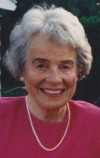
1920-2009
1987 photo
Parents
- Father: Edmund Stanley Male (b. 30 November 1888, d. 18 September 1957)
- Mother: Doris Laura Wooley (b. 25 August 1896, d. 7 August 1968)
Biography
- Barbara Lois Male was born on 21 August 1920 in Chicopee Falls, Massachusetts.
- In 1925 Barbara Lois Male lived at 48 Treadwell St, Whitneyville, Connecticut, with her parents.1
 48 Treadwell St
48 Treadwell St
Whitneyville CT
1931 photo - She appeared on the 1930 US Federal Census of 48 Treadwell St, Hamden, New Haven County, Connecticut, enumerated on 9 May 1930, in the household of her parents Edmund Stanley Male and Doris.2
- Barbara Lois Male moved with her parents Edmund and Doris in 1934 to 92 Mather St, Hamden, Connecticut.1
 92 Mather St Hamden CT.
92 Mather St Hamden CT.
Probably the 2 older girls and Doris on front lawn. 92 Mather St
92 Mather St
Hamden CT
home of Ed & Doris Male & family
(written on back: Mather St facing East) - Barbara Lois Male graduated from Larson Junior College, New Haven, Connecticut, in June 1939.3
- She was employed by Dr Arthur Connolly; 59 Trumbull St, New Haven, Connecticut, in September 1940 as a secretary for her first job.3
- Barbara married Richard Collier Sargent, Jr, son of Richard Collier Sargent and Ruth Kingsbury, on 8 March 1941 in New Haven, Connecticut.3
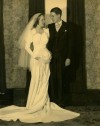 Barbara Male & Richard Collier Sargent Jr
Barbara Male & Richard Collier Sargent Jr
8 Mar 1941
New Haven, CT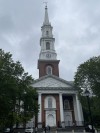 Center Church on the Green
Center Church on the Green
New Haven, CT
site of wedding of
Richard Sargent & Barbara Male in 1941
2023 photo - In July 1945 Barbara and Richard moved to 2078 Huntington Tpke, Nichols, ConnecticutG, where they raised their family of 3 girls and a boy. They lived in Nichols for 24 years.3
 2078 Huntington Tpke
2078 Huntington Tpke
Nichols CT
1948 photo - Richard Collier Sargent, Jr, and Barbara appeared on the 1950 US Federal Census of 2078 Huntington Tpke, Other Places???????, Fairfield County, Connecticut, enumerated on 13 April 1950. The house is not a farm and is on land of over 3 acres.4
- In 1952 my mother Barbara Male Sargent was involved in collection donations to help Koreans displaced by the war. This photo was taken in Nichols CT at our house. The two Barbaras were related in 8 different ways, the closest being 7th cousins by marriages - and I'm sure they didn't know this.3
 Misc_Sargent_Crandon1952_Korea
Misc_Sargent_Crandon1952_Korea - In May 1957 in Ridge Road, North Haven, Connecticut, Barbara Lois Male attended a family reunion where this photo was taken. Her father-in-law hosted the reunion as his siblings were visiting from California.3
 Family Reunion 1957 children of
Family Reunion 1957 children of
George Lewis Sargent
Ridge Rd, North Haven CT - In September 1962 In 1962 Mom & Dad bought the house in Hartland Vermont to use as a ski house and eventual place to retire. They bought it from the Sperry family - of Waterbury CT. My father had actually know the 'Sperry girls' as he was growing up. They went up weekends - and sometimes summers.3
 Hartland VT in the 1960s (before my parents bought the house)
Hartland VT in the 1960s (before my parents bought the house) Hartland VT
Hartland VT - In 1966 For their twenty-fifth wedding anniversary Mom and Dad went on a boat in the Caribbean that they sailed themselves from Martinique to Grenada.3
- 4 generations of women - Doris, Barbara, Linda and Lisa.3
 Linda Sargent Reinfeld, Doris Woolley Male holding Lisa Joan Reinfeld, Barbara Male Sargent
Linda Sargent Reinfeld, Doris Woolley Male holding Lisa Joan Reinfeld, Barbara Male Sargent
Nov 1967 - In May 1969 In 1969 after my father retired they moved up to VT full time. My father became a 'gentleman farmer'. He raised Polled Herefords, and supplied his family with beef and veal every year.3
- Hartland Vermont became a central place for the family after my parents moved up full time. It also became a central place for Hartland residents - every summer the town conducted swimming lessons at the pond.3
 Hartland Vermont, in the 1980s
Hartland Vermont, in the 1980s
the pond enlarged, shed built,
2 trees still standing, for the hammock
Favorite Vermont photos of BMS - made into a postcard - Her husband Richard Collier Sargent, Jr, died leaving her a widow at age 71.
- 4 generations.
 Barbara Male Sargent, Lisa Reinfeld Mueller holding Hannah Mueller, Linda Sargent Reinfeld
Barbara Male Sargent, Lisa Reinfeld Mueller holding Hannah Mueller, Linda Sargent Reinfeld
Jul 2003 - 4 generations.
 Saral D Doolan, Carol S Dunning, Barbara M Sargent
Saral D Doolan, Carol S Dunning, Barbara M Sargent
Stella Doolan
Jul 2003 - 4 Generations.
 Linda Sargent Reinfeld, David Sargent Reinfeld, Barbara Male Sargent, John Sargent Reinfeld
Linda Sargent Reinfeld, David Sargent Reinfeld, Barbara Male Sargent, John Sargent Reinfeld
Nov 2008 - She died on 3 March 2009 in Windsor, Vermont, at age 88.3
- She was buried in Evergreen Cemetery, New Haven, Connecticut.3
 Gravestone
Gravestone - An obituary was published in the Valley News and the Vermont Standard.3
Family: Richard Collier Sargent, Jr, (b. 5 April 1914, d. 17 April 1985)
- Linda Sargent
 +
+ - Carol Sargent+
- Joan Sargent+ (b. 11 July 1945, d. 2 December 1997)
- Richard Collier Sargent, III+
Story
My Mother's tribute to her brother-in-law Fred Sargent, upon his death....
In 1939 I had met Fred Sargent first and then met Dick Sargent just before they left to bike around Europe. On the boat going over Dick met Janet first as she was heading for a summer on the Experiment. And then Fred met her. In 1941 Dick and I married in March, Fred and Janet in August, and our lives and families have been intertwined ever since. Dear Fred was planning to be a doctor and was so loving and caring about people that I felt he had chosen well. His sense of humor and complete lack of bigotry or snobbery are qualities I shall never forget. He was a wonderful brother-in-law, and true friend. I loved him very much.
Other Information
-
Relationship:
Mother of Linda Sargent
Aunt of Julianne Stoughton - Charts/Lists: Ancestors of Barbara Lois Male, Cemeteries of Connecticut, Descendants of JBS (with spouses), Dunning Family, Male Family, My Ancestors, Sargent Family of New Haven, Story List of People
- Last Edited: 27 October 2025 12:45:10
Citations
Heidi Elizabeth Reinfeld





- Sargent Lineage: Linda Sargent11, Richard10, Richard9, George8, Joseph7, Joseph6, Joseph5, Joseph4, Joseph3, Joseph2, John1, William0
Parents
- Father: William Reinfeld
- Mother: Linda Sargent
Family: Casey Saunders Bivens
Other Information
-
Relationship:
Daughter of Linda Sargent
Daughter of William Reinfeld
11th cousin 1 time removed of Kyle Lawrence Mueller
16th cousin of Casey Saunders Bivens
1st cousin 1 time removed of Julianne Stoughton - Charts/Lists: Bivens Family, Descendant Chart for Elizabeth Alsop, Descendant Chart for Griffith Bowen, Descendant Chart for Thomas Trowbridge (#1), Descendant Chart for Thomas Trowbridge (#2), Descendants of JBS, Descendants of JBS (with spouses), Descendants of Nathaniel Foote and Elizabeth Deming, Descendants of Sarah Talcott & William Wadsworth, Descendants of William Sargent, Immigrant, Descent from Henry Kingsbury, Forbes Family, Joseph Smith and Linda, Kingsbury Family, Male Family, Moore and Nicholas, Norman Rockwell and Heidi, Reinfeld Family, Samuel F B Morse and Nicholas, Sargent Family of New Haven, Tiffany and Maxwell
- Last Edited: 27 October 2025 12:45:10
Richard Collier Sargent, Jr





- Sargent Lineage: Richard9, George8, Joseph7, Joseph6, Joseph5, Joseph4, Joseph3, Joseph2, John1, William0
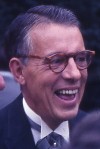
1914-1985
1966 photo (at my wedding)
Parents
- Father: Richard Collier Sargent (b. 29 August 1888, d. 29 January 1962)
- Mother: Ruth Kingsbury (b. 29 August 1887, d. 8 December 1956)
Biography
- Richard Collier Sargent, Jr, was born on 5 April 1914 in New Haven, Connecticut.1
- He was usually called Dick.
- Richard lived in 326 Willow St, New Haven, Connecticut, The house where my father lived from his birth until he was about 18. They lived on the 2nd and 3rd floor; because the house had it's long side to the street they had a big back yard. My grandparents remained friendly with the downstairs neighbors, the Daggets, for the rest of their life. Even though they lived in a 2-family they still had maids....1
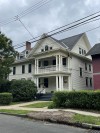 326 Willow St
326 Willow St
home of Richard & Ruth Sargent
Richard (son) and Fred
2023 photo - On 24 May 1924 Richard Collier Sargent, Jr, attended a family reunion where this photo was taken.2
 FamReunion_Sargent_JohnInGreen
FamReunion_Sargent_JohnInGreen - He attended school at Phillips Academy, Andover, Massachusetts, for two years.1
- In 1931 Dick and his brother, along with their parents and their mother's aunt Alice Kingsbury vacationed in Bermuda. (He promised his daughters a similar trip when they all had the same school vacation - which occurred in March 1960. It was a wonderful spring break trip.)1
- He graduated from The Taft School, Watertown, Connecticut, in 1933.1
- He attended school at Bates College, Lewiston, Maine, for a year and a half.1,3
- A family story says that he first stopped off at Bowdoin College down the road, but realized that wasn't his school, so he traveled up to Bates.....He lived at 7 Vale St (as discovered on the flyleaf of a book he owned).1,3
- Richard lived in 7 Vale St, Lewiston, Maine, while attending Bates Cllege. (address found on flyleaf of books he owned.1
- He was employed by Bridgeport Brass Company, Bridgeport, Connecticut, about 1940 as a foreman in the annealing department. He worked there for 24 years, until he retired in 1964.1
When my father started dating my mother and they were getting 'serious' he had been selling insurance to members of his family.This was considered a responsible job by his family, as he was just 'starting out' However, my mother didn't think that qualified as a real job at all. So he went to a company he knew about - the Bridgeport Brass Company - his grandfather was president of the company at the time. However, I do not believe he (FJ Kingsbury) knew that his grandson had applied to work there. The first day of work he brought out his lunchbox at noon, with the other employees in the factory, and when he opened it he saw all the sandwiches had their crusts cut off. (I think they were cucumber sandwiches). The lunch had been made by the cook, and this was her custom. Needless to say he put away the lunch and went hungry that day!
After a couple of weeks his grandfather found out his grandson was working on the shop floor, called him to his office and offered him a management position. But my father wanted to stay where he was, and so turned down an opportunity to advance in the manufacturing world.
A year or so later America entered WW II. The Brass company employees were given a deferment because they were doing 'war work'. My father was one of the first to receive this deferment. There were photos, interviews, because he was among the first. After a few months the process became routine and it no longer merited special attention.1
- He appeared on the 1940 US Federal Census of Ridge Road, North Haven, New Haven County, Connecticut, enumerated on 4 May 1940, in the household of his parents Richard Collier Sargent and Ruth.4
- On 16 October 1940 my father registered for the draft. At that time he wasn't married, and lived with his parents. That address was crossed out & his new married address was typed in - at some later date.5
 DraftCard
DraftCard - Richard married Barbara Lois Male, daughter of Edmund Stanley Male and Doris Laura Wooley, on 8 March 1941 in New Haven, Connecticut.1
 Barbara Male & Richard Collier Sargent Jr
Barbara Male & Richard Collier Sargent Jr
8 Mar 1941
New Haven, CT Center Church on the Green
Center Church on the Green
New Haven, CT
site of wedding of
Richard Sargent & Barbara Male in 1941
2023 photo - Four generations of Kingsburys.1
 4 generations
4 generations
Richard Sargent, Linda Sargent
Ruth Kingsbury Sargent, Adele Townsend Kingsbury - The house my parents bought in Nichols CT had been built by my father's 2nd cousin 5 times removed, Everard Curtis. I don't think he had any idea of that connection.
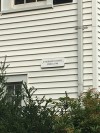 2078 Huntington Tpke
2078 Huntington Tpke
house built by Everard Curtis in c1790 - In July 1945 Richard and Barbara moved to 2078 Huntington Tpke, Nichols, ConnecticutG, where they raised their family of 3 girls and a boy. They lived in Nichols for 24 years.1
 2078 Huntington Tpke
2078 Huntington Tpke
Nichols CT
1948 photo - He and Barbara appeared on the 1950 US Federal Census of 2078 Huntington Tpke, Other Places???????, Fairfield County, Connecticut, enumerated on 13 April 1950. The house is not a farm and is on land of over 3 acres.6
- In May 1957 in Ridge Road, North Haven, Connecticut, Richard Collier Sargent, Jr, attended a family reunion where this photo was taken.1
 Family Reunion 1957 children of
Family Reunion 1957 children of
George Lewis Sargent
Ridge Rd, North Haven CT - In September 1962 In 1962 Mom & Dad bought the house in Hartland Vermont to use as a ski house and eventual place to retire. They bought it from the Sperry family - of Waterbury CT. My father had actually know the 'Sperry girls' as he was growing up. They went up weekends - and sometimes summers.1
 Hartland VT in the 1960s (before my parents bought the house)
Hartland VT in the 1960s (before my parents bought the house) Hartland VT
Hartland VT - In 1966 For their twenty-fifth wedding anniversary Mom and Dad went on a boat in the Caribbean that they sailed themselves from Martinique to Grenada.1
- In May 1969 In 1969 after my father retired they moved up to VT full time. My father became a 'gentleman farmer'. He raised Polled Herefords, and supplied his family with beef and veal every year.1
- Dick was a town lister (tax assessor) for the town of Hartland. He also enjoyed skiing very much - he had started skiing almost at the beginning of the sport here in America. The first rope tow in America was at Woodstock Vermont in 1934 - and my father went skiing there shortly after, and never stopped.1
- He died on 17 April 1985 in Hartland, Vermont, at age 71.
- The cause of his death was a brain tumor.1
- He was buried in Evergreen Cemetery, New Haven, Connecticut. Plot: Section Spruce Avenue, Pot: 1394, Grave 3.1,7
 Gravestone
Gravestone
Family: Barbara Lois Male (b. 21 August 1920, d. 3 March 2009)
- Linda Sargent
 +
+ - Carol Sargent+
- Joan Sargent+ (b. 11 July 1945, d. 2 December 1997)
- Richard Collier Sargent, III+
Obituary Notice
Richard C Sargent
Hartland - Richard Collier Sargent Jr, 71, died Friday morning in the hospice room at Mount Ascutney Hospital in Windsor. He was born April 5, 1914, in New Haven, Conn., son of Richard and Ruth (Kingsbury) Sargent Sr. He received his education in New Haven. He attended Andover Preparatory School and graduated from Taft Preparatory School. He later attended Bates College.
He married Barbara Male in New Haven, on March 8, 1941. He was supervisor at the Bridgeport Brass Co. in Bridgeport for 24 years. He had lived Trumbull, Conn., for 24 years before moving to Harland in 1970. He was a town meeting representative in Trumbull, Conn., clerk of the fire department, and treasurer and member of the board of trustees at Nichols Methodist Church in Trumbull. He was a member of the Woodstock Country Club, the 70 Plus Ski Club, the Hartland Nature Club and the Republican Town Committee in Hartland. He was treasurer of the Hartland Congregational Church, and chairman of the Hartland Board of Listers for nine years.
Survivors include his wife of Hartland; a son, Richard C. Sargent III of Hartland; three daughters, Linda Reinfeld of Winchester, Mass., Carol Dunning of Hopkinton, N.H., and Joan Sarget of Boulder, Colo.; a brother, Dr. Fredrick Sargent of San Fransicso, Cal.; six grandchildren; and 12 neices and nephews.
A service will be held April 27 at 3 p.m. at the Hartland Congregational Church, with the Rev. Susanna Griefen officiating. Following cremation, burial will be held in the Evergreen Cemetery in New Haven. Contributions may be made to the Mount Ascutney Hospital or the Hartland Congregational Church. The Knight Funeral Home in Windsor is in charge of the funeral arrangements.8
Story
Other Information
-
Relationship:
Father of Linda Sargent
9th cousin 3 times removed of Kyle Lawrence Mueller
14th cousin 2 times removed of Casey Saunders Bivens
8th cousin 2 times removed of Julianne Stoughton - Charts/Lists: Aaron Burr, related to the Sargents, Amelia Earhart and Sophie, Barnum and Joan, Cemeteries of Connecticut, Charlemagne and Sargents, Charles Ives and Linda, Clara Barton and Linda, Cole Porter - a Kingsbury, Descendant Chart for Elizabeth Alsop, Descendant Chart for Griffith Bowen, Descendant Chart for Thomas Trowbridge (#1), Descendant Chart for Thomas Trowbridge (#2), Descendants of JBS, Descendants of JBS (with spouses), Descendants of Nathaniel Foote and Elizabeth Deming, Descendants of Sarah Talcott & William Wadsworth, Descendants of William Sargent, Immigrant, Descent from Henry Kingsbury, Dunning Family, Eleanor of Aquitaine and LSR, Emily Dickinson and the Kingsburys, Forbes Family, Frank W Woolworth, Gilbert Clifford Noble and Linda, Henry Luce and Linda, Jane Fonda and Ruby, Jodie Foster and Sophie, John Wellborn Root and Carol, Joseph Smith and Linda, Katherine Hepburn and Linda Sargent, Kingsbury Family, Kyle and Lisa (husband and wife) are related!, Les and Dick related, Louisa May Alcott and the Kingsbury Relations, Lucille Ball and Charlotte, Male Family, Moore and Nicholas, My Ancestors, Nancy Reagan and Richard Sargent, Nathan Hale and Jack, Norman Rockwell and Heidi, Orville Wright and David, President Calvin Coolidge - a Sargent, President Franklin D Roosevelt, President Franklin Pierce and the Sargents, President Gerald Ford and Linda, President Grover Cleveland and the Forbes, President James A Garfield and Linda Sargent, President Rutherford B Hayes and the Forbes, President/General Grant and Richard Sargent, Prince William and Hannah, Relationship Brigham Young, Relationship Camilla Shand, Richard Nixon and Linda, Richrd Gere - a Kingsbury, Samuel F B Morse and Nicholas, Sargent Family of New Haven, Sigourney Weaver and Stella, Story List of People, Taft and Tate, Taylor Swift and Margot, Tennessee Williams and the Kingsburys, Thomas Alva Edison and Tasha, Tiffany and Maxwell, Warren Buffett and David, Winston Churchill and Lisa
- Last Edited: 22 November 2025 14:09:25
Citations
Doris Laura Wooley

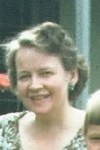
1896-1968
1948 photo
Parents
- Father: Arthur Wooley (b. 12 June 1862, d. 20 July 1945)
- Mother: Rosella Hague (b. 25 March 1862, d. 6 November 1934)
Biography
- Doris Laura Wooley was born on 25 August 1896 in Springfield, Massachusetts.
- She appeared on the 1900 US Federal Census of 927 Sutter St, San Francisco, San Francisco County, California, enumerated on 7 June 1900, in the household of her parents Arthur Wooley and Rosella.1
- Doris Laura Wooley lived in 26 Arlington St, Chicopee, Massachusetts, with her parents.
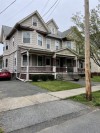 26 Arlington St
26 Arlington St
Chicopee, MA
home of Arthur & Rosella Wolley & family
2022 photo - She appeared on the 1910 US Federal Census of 26 Arlington St, Chicopee, Hampden County, Massachusetts, enumerated on 15 April 1910, in the household of her parents Arthur Wooley and Rosella.2
- Doris had dated Lloyd del Castilio (her brother-in-law) before she married Ed, her husband.3
- Doris married Edmund Stanley Male, son of John Male and Zipporah Elizabeth Bird, on 2 March 1918 in Chicopee Falls, Massachusetts.4
- After they married Ed and Doris lived with her parents at 26 Arlington St in Chicopee Falls. At some point they moved to Iowa.5
 photo probably Spring 1919
photo probably Spring 1919- Edmund Stanley Male and Doris appeared on the 1920 US Federal Census of 419 Oneida Ave, Davenport, Scott County, Iowa, enumerated on 5 January 1920. They rent their home.6
- She was a musician - she taught piano, sang in choirs and gave singing lessons.4
- In 1925 Edmund and Doris lived at 48 Treadwell St, Whitneyville, Connecticut.7
 48 Treadwell St
48 Treadwell St
Whitneyville CT
1931 photo - When Doris and Ed married they lived in Davenport, IO and then moved to Chicopee Falls until 1920 (when daughter Barbara was born - they lived with her parents). Next they moved to West Haven, 6 blocks from the water where Doris took her children to the beach in the wagon. Then they moved in West Haven to Washington St and then to Elm Street between First and Second when Jani was a baby. Next, Treadwell St second house from the cemetery, on the second floor - they moved downstairs to the first floor after Ed had his accident. and lost his arm. Mather Street was next, and then Skiff Street, which was the favorite house. Eventually, after the two older girls married they moved to Filbert Street.3
- Doris was always looking to better her daughters, she was bound that they would have a better life than she. She always aspired to better houses, spoke well in the house, etc.3
- Edmund Stanley Male and Doris appeared on the 1930 US Federal Census of 48 Treadwell St, Hamden, New Haven County, Connecticut, enumerated on 9 May 1930. The home was rented for $60 a month, and they owned a radio.8
- In 1934 Doris and Edmund moved to 92 Mather St, Hamden, Connecticut.7
 92 Mather St Hamden CT.
92 Mather St Hamden CT.
Probably the 2 older girls and Doris on front lawn. 92 Mather St
92 Mather St
Hamden CT
home of Ed & Doris Male & family
(written on back: Mather St facing East) - Doris and Edmund moved to Skiff Street, Hamden, Connecticut.4
- Doris and Edmund moved to 140 Filbert St, Hamden, Connecticut.4
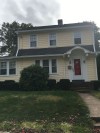 140 Filbert St
140 Filbert St
Handem CT
2017 photo
Home of Ed and Doris Male - In 1951 Ed and Doris bought a tiny cottage in Madison CT. With a lot of hard work they enlarged it to 2 (3?) bedrooms and a 'dog house' where Ed slept. The family, children and grandchildren spent many wonderful summers there.4
 cottage at the beach for Doris & Ed Male
cottage at the beach for Doris & Ed Male
Madison CT
1952 photo
Barbara Sargent, Carol & Joan - 4 generations of women - Doris, Barbara, Linda and Lisa.4
 Linda Sargent Reinfeld, Doris Woolley Male holding Lisa Joan Reinfeld, Barbara Male Sargent
Linda Sargent Reinfeld, Doris Woolley Male holding Lisa Joan Reinfeld, Barbara Male Sargent
Nov 1967 - She died on 7 August 1968 in New Haven, Connecticut, at age 71.4
- The cause of her death was bone cancer.4
- She was buried in Fairview Cemetery, Chicopee, Massachusetts.9,10
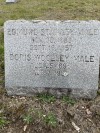 Gravestone
Gravestone
Family: Edmund Stanley Male (b. 30 November 1888, d. 18 September 1957)
- Phyllis Bird Male+ (b. 27 September 1918, d. 19 August 2016)
- Barbara Lois Male
 + (b. 21 August 1920, d. 3 March 2009)
+ (b. 21 August 1920, d. 3 March 2009) - Janice Ann Male+ (b. 30 July 1927, d. 11 June 1974)
Other Information
-
Relationship:
Grandmother of Linda Sargent
Grandmother of Julianne Stoughton - Charts/Lists: Ancestors of Barbara Lois Male, Ancestors of Jensi Stoughton, Cemeteries of Massachusetts, Male Family, Musicians, My Ancestors
- Last Edited: 24 November 2025 18:57:31
Citations
Lisa Joan Reinfeld





- Sargent Lineage: Linda Sargent11, Richard10, Richard9, George8, Joseph7, Joseph6, Joseph5, Joseph4, Joseph3, Joseph2, John1, William0
Parents
- Father: William Reinfeld
- Mother: Linda Sargent
Other Information
-
Relationship:
Daughter of Linda Sargent
Daughter of William Reinfeld
11th cousin 1 time removed of Kyle Lawrence Mueller
16th cousin of Casey Saunders Bivens
1st cousin 1 time removed of Julianne Stoughton - Charts/Lists: Descendant Chart for Elizabeth Alsop, Descendant Chart for Griffith Bowen, Descendant Chart for Thomas Trowbridge (#1), Descendant Chart for Thomas Trowbridge (#2), Descendants of JBS, Descendants of JBS (with spouses), Descendants of Nathaniel Foote and Elizabeth Deming, Descendants of Sarah Talcott & William Wadsworth, Descendants of William Sargent, Immigrant, Descent from Henry Kingsbury, Forbes Family, Kingsbury Family, Kyle and Lisa (husband and wife) are related!, Lucille Ball and Charlotte, Male Family, Mueller Family, Musicians, Prince William and Hannah, Reinfeld Family, Sargent Family of New Haven, Winston Churchill and Lisa
- Last Edited: 27 October 2025 12:45:10
David Sargent Reinfeld





- Sargent Lineage: Linda Sargent11, Richard10, Richard9, George8, Joseph7, Joseph6, Joseph5, Joseph4, Joseph3, Joseph2, John1, William0
Parents
- Father: William Reinfeld
- Mother: Linda Sargent
Other Information
-
Relationship:
Son of Linda Sargent
Son of William Reinfeld
11th cousin 1 time removed of Kyle Lawrence Mueller
16th cousin of Casey Saunders Bivens
1st cousin 1 time removed of Julianne Stoughton - Charts/Lists: Amelia Earhart and Sophie, Descendant Chart for Elizabeth Alsop, Descendant Chart for Griffith Bowen, Descendant Chart for Thomas Trowbridge (#1), Descendant Chart for Thomas Trowbridge (#2), Descendants of JBS, Descendants of JBS (with spouses), Descendants of Nathaniel Foote and Elizabeth Deming, Descendants of Sarah Talcott & William Wadsworth, Descendants of William Sargent, Immigrant, Descent from Henry Kingsbury, Forbes Family, Jodie Foster and Sophie, Kingsbury Family, Male Family, Nathan Hale and Jack, Orville Wright and David, President Franklin D Roosevelt, Reinfeld Family, Relationship Brigham Young, Sargent Family of New Haven, Taylor Swift and Margot, Uhrick Family, Warren Buffett and David
- Last Edited: 27 October 2025 12:45:10
Richard Collier Sargent



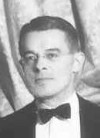
1888-1962
1930 photo
Parents
- Father: George Lewis Sargent (b. 26 July 1862, d. 5 February 1944)
- Mother: Alice Bessie Forbes (b. 7 February 1864, d. 5 May 1902)
Biography
- Richard Collier Sargent was born on 29 August 1888 in New Haven, Connecticut.
- He was mentioned in a letter. JBS, during a whooping cough epidemic, wrote to his wife Florence who was visiting in Lakewood NJ:
...This forenoon I spent an hour or more playing with Lawton, Bradford and with Bessie's older children.1 - He appeared on the 1900 US Federal Census of 251 Church St, New Haven, New Haven County, Connecticut, enumerated on 1 June 1900, in the household of his parents George Lewis Sargent and Alice.2
- When he was 13 his mother Alice died on 5 May 1902 in New Haven, Connecticut, at age 38.
- I (LSR) have a book - King Henry IV - that is inscribed Richard C Sargent 583 Pierson. Andover? or Yale? The writing is youngish. I have books inscribed White Hall, 1910, which means Yale.
- Richard Collier Sargent graduated from Philips Academy, Andover, Massachusetts, about 1906.3
- At Yale Richard was a collector for Yale in China. He also was a member of the class golf and hockey teams. He continued playing golf throughout his life.3,4
- He appeared on the 1910 US Federal Census of 256 Edwards St, New Haven, New Haven County, Connecticut, enumerated in 1910, in the household of his father George Lewis Sargent.5
- Sixty-five years later, in 1965, this researcher - Linda Sargent - rented a room in this house (256 Edwards St in New Haven) when she was attending Yale, not knowing that it was the house in which her grandfather had grown up!3
- I have in my library (Cambridge, MA, Jan 2008) 11 volumes of poetry of Robert Browning inscribed with Richard C Sargent, 368 White Hall, Tuesday January 11, 1910. (White Hall was a residential college dorm at Yale built in the 1890s and then replaced in 1934 by Berkeley College.)3
- An inscription written in the book Tristram Shandy is: Richard C Sargent, 34 Vanderbilt Hall, New Haven, Tuesday, February 21, 1911. This was the room he occupied while at Yale in his senior year.....
- Richard Collier Sargent graduated from Yale College, New Haven, Connecticut, in 1911 He entered Yale with the class of 1910 but graduated with the class of 1911.3,4
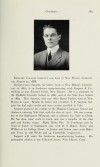 Richard C Sargent
Richard C Sargent
Yale 1911 - Richard married Ruth Kingsbury, daughter of Frederick John Kingsbury and Adele Townsend, on 21 June 1913 in New Haven, Connecticut. Richard and Ruth are related by at least 10 different relationships, the closest (other than marriage) being seventh cousins.
- Richard and Ruth lived at 326 Willow St, New Haven, Connecticut.3
- Richard was a businessman in Sargent & Company. In 1921 on the 10th anniversary of his graduation from college he was the assistant sales manager in charge of tools and specialities, and office manager for the sales department.3,67
 Richard C Sargent milltary cen
Richard C Sargent milltary cen- Unfortunately there were too many Sargent 'cousins' working at the company, and he was encouraged to take early retirement.3,6
- On 24 May 1924 Richard Collier Sargent attended a family reunion where this photo was taken.8
 FamReunion_Sargent_JohnInGreen
FamReunion_Sargent_JohnInGreen - On 4 April 1931 Dick and Ruth returned to New York City on the ship Veendam from Hamilton, Bermuda. They traveled with their two sons, Richard and Fred, and Ruth's aunt, Alice Kingsbury.9
- In 1935 Richard and Ruth moved to 3030 Ridge Rd, North Haven, Connecticut, into a house designed by Brad Tilney, the son of Richard's first cousin who was just beginning his architectural career.3
 3030 Ridge Road
3030 Ridge Road
North Haven, CT
2012 photo - He spent his time playing golf and tennis. Stamp collecting also was a hobby.3
- He belonged to the Graduates Club, the New Haven Country Club, the Lawn Club and Mory's Association, Inc., all in New Haven CT.6
- He and Ruth appeared on the 1940 US Federal Census of Ridge Road, North Haven, New Haven County, Connecticut, enumerated on 4 May 1940. They own their home with a reported vaue of $45,000. Also listed with the household were Hollis Manning age 28 servant & Neatha Manning age 25 servant.10
- He was described as 5' 9" tall, weighing 135 lbs, had brown eyes, gray hair and a dark complexion in 1942.11
- He appeared in a family photo in May 1957 in Ridge Road, North Haven, Connecticut, Dick hosted a family reunion, as a couple of his siblings were visiting from California. Only 1 sibling was missing - Howard.3
 Family Reunion 1957 children of
Family Reunion 1957 children of
George Lewis Sargent
Ridge Rd, North Haven CT - He died on 29 January 1962 in North Haven, Connecticut, at age 73.12
- The cause of his death was lung cancer.3
- He was buried in Evergreen Cemetery, New Haven, Connecticut.13
 Gravestone
Gravestone
Family: Ruth Kingsbury (b. 29 August 1887, d. 8 December 1956)
- Richard Collier Sargent, Jr
 + (b. 5 April 1914, d. 17 April 1985)
+ (b. 5 April 1914, d. 17 April 1985) - Frederick Kingsbury Sargent+ (b. 29 April 1916, d. 2 February 1996)
Other Information
-
Relationship:
Grandfather of Linda Sargent
10th cousin 2 times removed of Kyle Lawrence Mueller
13th cousin 3 times removed of Casey Saunders Bivens
8th cousin 1 time removed of Julianne Stoughton - Charts/Lists: Aaron Burr, related to the Sargents, Cemeteries of Connecticut, Charlemagne and Sargents, Charles Ives and Linda, Clara Barton and Linda, Descendant Chart for Griffith Bowen, Descendant Chart for Thomas Trowbridge (#1), Descendant Chart for Thomas Trowbridge (#2), Descendants of JBS, Descendants of JBS (with spouses), Descendants of Sarah Talcott & William Wadsworth, Descendants of William Sargent, Immigrant, Forbes Family, Frank W Woolworth, Henry Luce and Linda, Jane Fonda and Ruby, John Brown and Leslie, John Wellborn Root and Carol, Joseph Smith and Linda, Katherine Hepburn and Linda Sargent, Les and Dick related, Lucille Ball and Charlotte, My Ancestors, Orville Wright and David, President Calvin Coolidge - a Sargent, President Franklin D Roosevelt, President Franklin Pierce and the Sargents, President Grover Cleveland and the Forbes, President James A Garfield and Linda Sargent, President Rutherford B Hayes and the Forbes, President/General Grant and Richard Sargent, Queen Elizabeth and Leslie Sargent, Relationship Brigham Young, Relationship Camilla Shand, Samuel F B Morse and Nicholas, Sargent Family of New Haven, Sigourney Weaver and Stella, Taft and Tate, Taylor Swift and Margot, Tiffany and Maxwell, Walt Disney and Tim Sargent, Warren Buffett and David, Wilbur Wright and Dylan Slaughter, Yale Alumns
- Last Edited: 28 November 2025 12:57:15
Citations
George Lewis Sargent


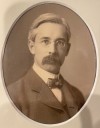
1862-1944
Parents
- Father: Joseph Bradford Sargent (b. 14 December 1822, d. 15 July 1907)
- Mother: Elizabeth Collier Lewis (b. 14 January 1829, d. 25 September 1874)
Biography
- George Lewis Sargent was born on 26 July 1862 in New Britain, Connecticut.
- He was usually called Lewis.1
- George Lewis Sargent lived at 51 Elm St, New Haven, Connecticut, with his parents.2
 51 Elm St
51 Elm St
New Haven CT
home of JBS Sargent & family of 12 children 51 Elm St
51 Elm St
New Haven CT
home of JBS Sargent & family of 12 children - He graduated from Yale University, New Haven, Connecticut, in 1881, receiving a degree from the Sheffield School.3
- He graduated from Yale Law School in June 1883.4,5
- He was employed by Sargent & Company, New Haven, Connecticut, in 1883 He started working there at age 21. He was treasurer for 30 years from 1887, vice-president 10 years and then president for 1 year. Afterwards he was a Director for 12 years until 1940.3
- George married Alice Bessie Forbes, daughter of Charles Forbes and Mary Archer Alvord, on 28 April 1886 in New York City, New York. Lewis and Bessie were fifth cousins.6
- They were married at St Andrew's Episcopal church.7,7
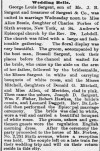 Marriage
Marriage - George Lewis Sargent and Alice appeared on the 1900 US Federal Census of 251 Church St, New Haven, New Haven County, Connecticut, enumerated on 1 June 1900. listed with four servants, Bridget Tobin age 37, Katie McKeon age 9, Mollie McKeon age 22, Sarah O'Melia age 40. Also identified is Mary A Forbes, mother-in-law, b Dec 1839, age 60 widown, 1 child, 1 child living, she was b in Ireland, as were her parents, & she was identified as a servant. Maybe she was the mother-in-law to one of the 4 girls....8
- His wife Alice died on 5 May 1902 in New Haven, Connecticut, leaving him a widower at age 39 .
- His brother Russell died on 16 April 1904 in Boston, Massachusetts, at age 39.
- George Lewis Sargent appeared on the 1910 US Federal Census of 256 Edwards St, New Haven, New Haven County, Connecticut, enumerated in 1910. Also listed with the family were Katie McDonald age 28 b Ireland servant and Margaret Stratton age 24 b Ireland servant.9
- George married Margaret Berrien Motte, daughter of Ellis Loring Motte and Annie Louise Lobdell, on 24 October 1911 in Concord, Massachusetts.
- Margaret's husband Russell died in 1904 and her husband's brother's wife (Alice Bessie Forbes Sargent) died in 1902; she married her brother-in-law George, who had 7 children at the time. They moved into a beautiful large brick home on Humphrey Street in New Haven, CT.3
- After his marriage Lewis moved with his family into Margaret's house just down the street at 360 Edwards St in New Haven.10
- On 24 May 1924 George Lewis Sargent attended a family reunion where this photo was taken.11
 FamReunion_Sargent_JohnInGreen
FamReunion_Sargent_JohnInGreen - He and Margaret appeared on the 1930 US Federal Census of 360 Edwards St, New Haven, New Haven County, Connecticut, enumerated on 16 April 1930. They own their home with a reported value of $40,000. Also listed with the family were Mary McNabola age 60 servant chambermaid and Anna C Chasson age 25 servant waitress.10
- He and Margaret appeared in a family photo in the Lawn Club, New Haven, Connecticut, in the 1930s.12
 George Lewis Sargent, his 2nd wife Margaret
George Lewis Sargent, his 2nd wife Margaret
his children and their spouses - He died on 5 February 1944 in New Haven, Connecticut, at age 81.
- He was buried in Evergreen Cemetery, New Haven, Connecticut. Plot: Section: Spruce Avenue, Plot: 1193, Grave: 16.13,14
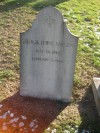 Gravestone
Gravestone When George was a student he lived at 51 Elm Street in New Haven. He lived there from 1883-1886. By 1887 he was living at 542 Chapel Street. In 1889 he moved to 251 Church St.
In 1900 the George Lewis Sargent family lived at 251 Church St. He had 5 maids from Ireland. (It is now a parking lot across from the Junior League Shop 1975).
GLS and family lived at #256 Edward St. After his second marriage he moved to 360 Edwards Street with his 7 children. Russell Sargent and Margaret his wife had built that house.
Recollections of his grandson RCS Jr.: The RCS Sr family was a matriarchy - they very rarely saw the GL Sargent family.15
Family: Alice Bessie Forbes (b. 7 February 1864, d. 5 May 1902)
- Eleanor Strong Sargent (b. 26 May 1887, d. 30 May 1892)
- Richard Collier Sargent
 + (b. 29 August 1888, d. 29 January 1962)
+ (b. 29 August 1888, d. 29 January 1962) - Sydney Forbes Sargent (b. 29 October 1889, d. 1 April 1971)
- Dorothy Sargent+ (b. 4 November 1891, d. 10 December 1974)
- Hilda Sargent+ (b. 6 April 1893, d. 20 September 1971)
- Mary Denny Sargent+ (b. 28 October 1894, d. 27 May 1965)
- Howard Lewis Sargent+ (b. 9 August 1896, d. 23 January 1987)
- Charles Forbes Sargent+ (b. 13 June 1898, d. 26 December 1985)
Family: Margaret Berrien Motte (b. 28 February 1866, d. 16 March 1948)
Obituary Notice
George Lewis Sargent (Uncle Lewis to most of us) died after a long illness early in the morning of Saturday, February 5th, in his 82nd year. He was the seventh of the twelve children of Joseph Bradford Sargent and Elizabeth Collier Lewis, and was born in New Britain, Conn., on July 26, 1862. Before the next child was born the family moved to New Haven.
With his brothers Ned and Joe he attended Hopkins Grammar School. All three boys were withdrawn from the school when Mr Cushing, the rector, threatened expulsion of Ned for something the boy had not done. (Too late Mr Cushing learned that he had been misinformed and apologized to Ned.) The boys completed their college preparatory work at Hillhouse High School, Joe and Lewis entering the Scheffield Scientific School of Yale a year after Ned in the Class of 1881. Joe did not complete the course (Yale later awarding him the degree) but Lewis graduated before his 19th birthday and then took the two-year course in the Yale Law School as further preparation for the family business.
Lawn tennis was a relatively new game in this country in 1883 when he becae the Yale champion and represented Yale in singles in the first intercollegiate tennis tournament at Hartford. (A Harvard man won it, a round robin affair.) Yale's representatives in doubles were Walter Camp and Henry W Slocum, later national singles champion.
In 1883 he entered the employ of Sargent & Company, was treasurer for thirty years from 1887, vice president for ten years and president for the last year of his active participation in the business, continuing however as a director till 1940.
He was married on April 28, 1886 to Alice Bessie Forbes, daughter of Charles Forbes of New York, who died in 1902. They had eight children. He was married on October 24, 1911, to Margaret Berrien Motte, the widow of his brother Russell and the daughter of Ellis Loring Motte of Boston, who survives him. Eleanor Strong, his oldest child, died in childhood. The other seven are Richard Collier, Sydney Forbes, Dorothy (Mrs Henry J Wiser), Hilda (Mrs Roswell G Ham), Mary Denny (Mrs William H McCance), Howard Lewis and Charles Forbes. Barbara Louise (Mrs Ludwig K Morrehead) is a niece and step-daughter. Seventeen grandchildren and three great grandchildren also survive him
Uncle Lewis Sargent, who died on February 5th, was endowed with a very keen sense of humor. He was a good player of games and sports. His friends called him a lucky player, but his ability to think clearly in the stress of competition made him a good 'match' player. He played his best in matches and never seemed to get rattled.
He and Uncle Bruce Fenn were members of the Friday Night Club of a social-literary nature which met in the homes of its members.
For many years he resided at 251 Church Street, New Haven, next door to the Henry B's at 247. When then brothers decided to have a telephone they shared an instrument, which was placed at the GL's. The obvious convenience for the latter when they wanted to make a telephone call was perhaps offset by the necessity of going next door to notify the HB's when one of the latter was wanted to answer a call.
The fence between the two back yards was removed to make one playground for all the children. When one of the brothers was out of town the other was looked to by both families in emergencies. One Sunday when HB was away GL was appealed to get rid of a terrible odor at 247. GB found the problem was a bit beyond him and after considerable effort got hold of a plumber, who solved the difficulty by removing a deceased feline from the cold air pipe to the furnace.
---written for Sargentrivia by Ziegler Sargent.16
Other Information
-
Relationship:
Great-grandfather of Linda Sargent
9th cousin 3 times removed of Kyle Lawrence Mueller
8th cousin 2 times removed of Julianne Stoughton - Charts/Lists: Aaron Burr, related to the Sargents, Cemeteries of Connecticut, Charlemagne and Sargents, Clara Barton and Linda, Descendant Chart for Griffith Bowen, Descendant Chart for Thomas Trowbridge, Descendants of JBS, Descendants of JBS (with spouses), Descendants of William Sargent, Immigrant, Jane Fonda and Ruby, John Brown and Leslie, John Wellborn Root and Carol, Katherine Hepburn and Linda Sargent, Les and Dick related, Lucille Ball and Charlotte, My Ancestors, President Calvin Coolidge - a Sargent, President Franklin Pierce and the Sargents, President James A Garfield and Linda Sargent, President/General Grant and Richard Sargent, Queen Elizabeth and Leslie Sargent, Relationship Brigham Young, Relationship Camilla Shand, Samuel F B Morse and Nicholas, Sargent Family of New Haven, Taft and Tate, Tiffany and Maxwell, Walt Disney and Tim Sargent, Warren Buffett and David, Yale Alumns
- Last Edited: 27 October 2025 12:45:10
Citations
Constantine Alexander

Parents
- Father: George Alexander (b. 23 April 1908, d. October 1986)
- Mother: Laura Margaret Sanseverino (b. 24 February 1918, d. 11 June 2009)
Family: Linda Sargent
Other Information
- Charts/Lists: Alexander Family, Ancestors of Constantine Alexander, Descendants of JBS (with spouses), Harvard Alumns List, Sargent Family of New Haven
- Last Edited: 27 October 2025 12:45:10
Alice Bessie Forbes

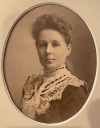
1864-1902
Parents
- Father: Charles Forbes (b. 10 April 1827, d. 18 April 1895)
- Mother: Mary Archer Alvord (b. 1836, d. 28 January 1865)
Biography
- Alice Bessie Forbes was born on 7 February 1864 in Suisun City, California+.1
- When Bessie was only two years old her mother Mary died on 28 January 1865 in Brooklyn, New York, at age ~29.2,3
- She lived with her Aunt Susan (Susan Forbes Silliman - her father Charles' sister who was married to Benjamin Silliman). She was known as Bessie. "I recall my mother always speaking of Bessie Forbes in a most loving way - she said she had great charm."4
- Alice Bessie Forbes appeared in a family photo about 1868 middle row, standing, age 4. The photo was taken following Thanksgiving dinner in Brooklyn NY. They are all grandchildren of Charlotte Antoinette (Root) and William Jehiel Forbes.5
 Grandchildren!
Grandchildren! - She appeared on the 1870 US Federal Census of New Haven, New Haven County, Connecticut, enumerated on 8 June 1870, in the household of Benjamin Silliman and Susan Huldah Forbes, her uncle and aunt.6
- Her aunt, with whom Bessie was living, Susan died on 26 March 1878 in New Haven, Connecticut, at age 59.
- Alice Bessie Forbes appeared on the 1880 US Federal Census of 226 West 54th St, New York City, New York County, New York, enumerated on 3 June 1880, in the household of her father Charles Forbes. and step-mother.7
- Alice married George Lewis Sargent, son of Joseph Bradford Sargent and Elizabeth Collier Lewis, on 28 April 1886 in New York City, New York. Lewis and Bessie were fifth cousins.8
- They were married at St Andrew's Episcopal church.9,9
 Marriage
Marriage - George Lewis Sargent and Alice appeared on the 1900 US Federal Census of 251 Church St, New Haven, New Haven County, Connecticut, enumerated on 1 June 1900. listed with four servants, Bridget Tobin age 37, Katie McKeon age 9, Mollie McKeon age 22, Sarah O'Melia age 40. Also identified is Mary A Forbes, mother-in-law, b Dec 1839, age 60 widown, 1 child, 1 child living, she was b in Ireland, as were her parents, & she was identified as a servant. Maybe she was the mother-in-law to one of the 4 girls....10
- She died on 5 May 1902 in New Haven, Connecticut, at age 38.
- She was buried in Evergreen Cemetery, New Haven, Connecticut.11
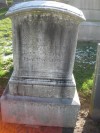 Gravestone
Gravestone - The cause of her death was TB. She lived in a sanatoriam for 2 years in the Adirondacks in an attempt to cure it.12
- 'Bessie died at her home in New Hampshire' NH is not the Adirondacks. Did the family have a (summer) house in NH?12
 CauseDeath
CauseDeath - ***Research Conclusion: There is much confusion in the records about Bessie's birth place. The IGI says New Haven, CT. 1860 census -CA, 1870 census-CT (wrong - that's where Susan Silliman's children were born), 1880 census-CA, 1900 census-CA, 1910 census children-CA, 1920 census children-MA (wrong - that is their step-mother) 1930 census children-NY. She was born in California - her sisters and brothers were born there. I have a copy of her sister's birth certificate.
Family: George Lewis Sargent (b. 26 July 1862, d. 5 February 1944)
- Eleanor Strong Sargent (b. 26 May 1887, d. 30 May 1892)
- Richard Collier Sargent
 + (b. 29 August 1888, d. 29 January 1962)
+ (b. 29 August 1888, d. 29 January 1962) - Sydney Forbes Sargent (b. 29 October 1889, d. 1 April 1971)
- Dorothy Sargent+ (b. 4 November 1891, d. 10 December 1974)
- Hilda Sargent+ (b. 6 April 1893, d. 20 September 1971)
- Mary Denny Sargent+ (b. 28 October 1894, d. 27 May 1965)
- Howard Lewis Sargent+ (b. 9 August 1896, d. 23 January 1987)
- Charles Forbes Sargent+ (b. 13 June 1898, d. 26 December 1985)
Other Information
-
Relationship:
Great-grandmother of Linda Sargent
12th cousin 4 times removed of Casey Saunders Bivens
8th cousin of Julianne Stoughton - Charts/Lists: Ancestors of Alice Bessie Forbes, Cemeteries of Connecticut, Charles Ives and Linda, Descendant Chart for Thomas Trowbridge, Descendants of JBS (with spouses), Descendants of Sarah Talcott & William Wadsworth, Forbes Family, Frank W Woolworth, Henry Luce and Linda, Joseph Smith and Linda, My Ancestors, Orville Wright and David, President Franklin D Roosevelt, President Grover Cleveland and the Forbes, President Rutherford B Hayes and the Forbes, Sargent Family of New Haven, Sigourney Weaver and Stella, Taylor Swift and Margot, Wilbur Wright and Dylan Slaughter
- Last Edited: 27 October 2025 12:45:10
Citations
Ruth Kingsbury

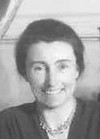
1887-1956
c 1930 photo
Parents
- Father: Frederick John Kingsbury (b. 7 July 1863, d. 11 July 1927)
- Mother: Adele Townsend (b. 23 August 1863, d. 17 February 1945)
Biography
- Ruth Kingsbury was born on 29 August 1887 in Waterbury, Connecticut.1
- She moved with her parents Frederick and Adele to Fairfield, Connecticut.
- Ruth Kingsbury appeared on the 1900 US Federal Census of 406 Humphrey Street, New Haven, New Haven County, Connecticut, enumerated on 1 June 1900, in the household of her parents Frederick John Kingsbury and Adele.2
- Ruth Kingsbury attended school at The Masters School, Dobbs Ferry, New York, She was very loyal to Dobbs, and encouraged all her granddaughters to attend.3
- She was mentioned in this newspaper with Huntington Norton and his fiance, her cousin Adele.4
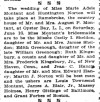 MarriagePlans
MarriagePlans - She appeared on the 1910 US Federal Census of 445 Humphrey St, New Haven, New Haven County, Connecticut, enumerated on 28 April 1910, in the household of her parents Frederick John Kingsbury and Adele.5
- Her grandfather Frederick died on 30 September 1910 in Waterbury, Connecticut, at age 87.6
- On 22 March 1911Alice Kingsbury, with her two nieces Ruth Kingsbury and Dorothy Bull, traveled to Liverpool on the ship Adelphi. They spent two and a half months visiting Stratford, Oxfors, London, Antwerp, the Hague, Cologne, Lucerne, Milan, Venice, Florence, Switzerland, Paris, Blois, Tours and back to Paris before heading back home, arriving 8 June in New York.7,8
- Ruth married Richard Collier Sargent, son of George Lewis Sargent and Alice Bessie Forbes, on 21 June 1913 in New Haven, Connecticut. Richard and Ruth are related by at least 10 different relationships, the closest (other than marriage) being seventh cousins.
- Richard and Ruth lived at 326 Willow St, New Haven, Connecticut.3
- On 24 May 1924 Ruth Kingsbury attended a family reunion where this photo was taken.9
 FamReunion_Sargent_JohnInGreen
FamReunion_Sargent_JohnInGreen - On 4 April 1931 Dick and Ruth returned to New York City on the ship Veendam from Hamilton, Bermuda. They traveled with their two sons, Richard and Fred, and Ruth's aunt, Alice Kingsbury.10
- In 1935 Ruth and Richard moved to 3030 Ridge Rd, North Haven, Connecticut, into a house designed by Brad Tilney, the son of Richard's first cousin who was just beginning his architectural career.3
 3030 Ridge Road
3030 Ridge Road
North Haven, CT
2012 photo - Richard Collier Sargent and Ruth appeared on the 1940 US Federal Census of Ridge Road, North Haven, New Haven County, Connecticut, enumerated on 4 May 1940. They own their home with a reported vaue of $45,000. Also listed with the household were Hollis Manning age 28 servant & Neatha Manning age 25 servant.11
- Four generations of Kingsburys.3
 4 generations
4 generations
Richard Sargent, Linda Sargent
Ruth Kingsbury Sargent, Adele Townsend Kingsbury - She died on 8 December 1956 in New Haven, Connecticut, at age 69.
- The cause of her death was lukemia.3
- She was buried in Evergreen Cemetery, New Haven, Connecticut.12
 Gravestone
Gravestone
Family: Richard Collier Sargent (b. 29 August 1888, d. 29 January 1962)
- Richard Collier Sargent, Jr
 + (b. 5 April 1914, d. 17 April 1985)
+ (b. 5 April 1914, d. 17 April 1985) - Frederick Kingsbury Sargent+ (b. 29 April 1916, d. 2 February 1996)
Story
The following excerpt from Sargentrivia, the family newspaper, illustrates the kind of activity women would participate in:
Ruth Kingsbury Sargent, Jane Cater Sargent, Elizabeth Collier Sargent, Elizabeth Day Sargent, Laura Rice Deming and Agnes W.B. Sargent were joint hostesses at Our Society meeting on April 21st at Ruth's home, Ridge Road, North Haven, Conn. Our Society is an ancient charitable sewing club founded in 1831 or 1832 to provide women's and children's garments for the needy. The membership is now limited to 130, with preference given to daughters of members in the filling of vacancies. Because of its size only 3 or 4 meetings (afternoon and supper) are held each year. To-day the work is concentrated on diapers. In the early days some gentlemen are known to have attended the meetings as guests, but for more than a hundred years all males have been excluded. Perhaps their presence was found a hindrance to the production of garments.13
Other Information
-
Relationship:
Grandmother of Linda Sargent
8th cousin 4 times removed of Kyle Lawrence Mueller
9th cousin 1 time removed of Julianne Stoughton - Charts/Lists: Amelia Earhart and Sophie, Ancestors of Ruth Kingsbury, Barnum and Joan, Cemeteries of Connecticut, Cole Porter - a Kingsbury, Descendant Chart for Elizabeth Alsop, Descendants of JBS (with spouses), Descendants of Nathaniel Foote and Elizabeth Deming, Descent from Henry Kingsbury, Eleanor of Aquitaine and LSR, Emily Dickinson and the Kingsburys, Ernest Hemingway and Mitchell, Gilbert Clifford Noble and Linda, Harriet Beecher Stowe and Kirsten, Jodie Foster and Sophie, Kingsbury Family, Kyle and Lisa (husband and wife) are related!, Louisa May Alcott and the Kingsbury Relations, Moore and Nicholas, My Ancestors, Nancy Reagan and Richard Sargent, Nathan Hale and Jack, Nathaniel Hawthorne and Kingsburys, Norman Rockwell and Heidi, President George Herbert Walker Bush, President Gerald Ford and Linda, President Millard Fillmore and the Kingsburys, Prince William and Hannah, Richard Nixon and Linda, Richrd Gere - a Kingsbury, Sargent Family of New Haven, Story List of People, Tennessee Williams and the Kingsburys, Thomas Alva Edison and Tasha, Winston Churchill and Lisa
- Last Edited: 27 October 2025 12:45:10
Citations
Carol Sargent




- Sargent Lineage: Richard10, Richard9, George8, Joseph7, Joseph6, Joseph5, Joseph4, Joseph3, Joseph2, John1, William0
Parents
- Father: Richard Collier Sargent, Jr (b. 5 April 1914, d. 17 April 1985)
- Mother: Barbara Lois Male (b. 21 August 1920, d. 3 March 2009)
Family: Robert Eugene Dunning, Jr, (b. 25 September 1943, d. 1 March 2006)
Other Information
-
Relationship:
Sister of Linda Sargent
10th cousin 2 times removed of Kyle Lawrence Mueller
15th cousin 1 time removed of Casey Saunders Bivens
1st cousin of Julianne Stoughton - Charts/Lists: Descendant Chart for Elizabeth Alsop, Descendant Chart for Griffith Bowen, Descendant Chart for Thomas Trowbridge (#1), Descendant Chart for Thomas Trowbridge (#2), Descendants of JBS, Descendants of JBS (with spouses), Descendants of Nathaniel Foote and Elizabeth Deming, Descendants of Sarah Talcott & William Wadsworth, Descendants of William Sargent, Immigrant, Descent from Henry Kingsbury, Dunning Family, Forbes Family, Frank W Woolworth, Jane Fonda and Ruby, John Wellborn Root and Carol, Kingsbury Family, Male Family, President Franklin Pierce and the Sargents, Relationship Camilla Shand, Sargent Family of New Haven, Sigourney Weaver and Stella, Taft and Tate, Thomas Alva Edison and Tasha
- Last Edited: 27 October 2025 12:45:10
Edmund Stanley Male

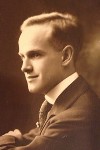
1888-1957
Parents
- Father: John Male (b. 30 June 1846, d. 29 September 1925)
- Mother: Zipporah Elizabeth Bird (b. 29 November 1853, d. 16 February 1913)
Biography
- Edmund Stanley Male was born on 30 November 1888 in Troy, New York.1
- He moved with his parents John and Zipporah to Fair Haven, Connecticut.2
- In 1894 his oldest sister, Louise, was his first grade teacher. He was very spoiled by his sisters.2
- His father wanted him to go to Yale, but he didn't want to go, so he quit school after sophmore year of high school.2
- Edmund Stanley Male was a draftsman in a gun shop.3
- He appeared on the 1910 US Federal Census of 140 Exchange St, New Haven, New Haven County, Connecticut, enumerated in June 1910, in the household of his parents John Male and Zipporah. identified as Edward.3
- Ed was really in love with Doris before they married. He persued her greatly. She went out with someone else once, someone in a Stutz Bearcat, and he waited across the street.2
- Edmund married Doris Laura Wooley, daughter of Arthur Wooley and Rosella Hague, on 2 March 1918 in Chicopee Falls, Massachusetts.1
- After they married Ed and Doris lived with her parents at 26 Arlington St in Chicopee Falls. At some point they moved to Iowa.4
- Edmund Stanley Male and Doris appeared on the 1920 US Federal Census of 419 Oneida Ave, Davenport, Scott County, Iowa, enumerated on 5 January 1920. They rent their home.5
- In 1925 Edmund and Doris lived at 48 Treadwell St, Whitneyville, Connecticut.6
 48 Treadwell St
48 Treadwell St
Whitneyville CT
1931 photo - In 1930 Edmund Stanley Male was a mechanical engineer in the rubber industry.7
- He and Doris appeared on the 1930 US Federal Census of 48 Treadwell St, Hamden, New Haven County, Connecticut, enumerated on 9 May 1930. The home was rented for $60 a month, and they owned a radio.7
- In 1934 Edmund and Doris moved to 92 Mather St, Hamden, Connecticut.6
 92 Mather St Hamden CT.
92 Mather St Hamden CT.
Probably the 2 older girls and Doris on front lawn. 92 Mather St
92 Mather St
Hamden CT
home of Ed & Doris Male & family
(written on back: Mather St facing East) - Edmund and Doris moved to Skiff Street, Hamden, Connecticut.1
- He was described as 5' 8" 155 lbs, gray eyes, blonde hair and light complexion - also missing his left arm in 1942.8
- Edmund and Doris moved to 140 Filbert St, Hamden, Connecticut.1
 140 Filbert St
140 Filbert St
Handem CT
2017 photo
Home of Ed and Doris Male - In 1951 Ed and Doris bought a tiny cottage in Madison CT. With a lot of hard work they enlarged it to 2 (3?) bedrooms and a 'dog house' where Ed slept. The family, children and grandchildren spent many wonderful summers there.1
 cottage at the beach for Doris & Ed Male
cottage at the beach for Doris & Ed Male
Madison CT
1952 photo
Barbara Sargent, Carol & Joan - He died on 18 September 1957 in New Haven, Connecticut, at age 68.1
- The cause of his death was lukemia.1
- He was buried in Fairview Cemetery, Chicopee, Massachusetts.9,10
 Gravestone
Gravestone
Family: Doris Laura Wooley (b. 25 August 1896, d. 7 August 1968)
- Phyllis Bird Male+ (b. 27 September 1918, d. 19 August 2016)
- Barbara Lois Male
 + (b. 21 August 1920, d. 3 March 2009)
+ (b. 21 August 1920, d. 3 March 2009) - Janice Ann Male+ (b. 30 July 1927, d. 11 June 1974)
Story
Other Information
-
Relationship:
Grandfather of Linda Sargent
Grandfather of Julianne Stoughton - Charts/Lists: Ancestors of Barbara Lois Male, Ancestors of Jensi Stoughton, Cemeteries of Massachusetts, Male Family, My Ancestors, Story List of People
- Last Edited: 12 November 2025 11:54:51
Citations
Robert Eugene Dunning, Jr


1943-2006
2001 photo
Parents
- Father: Robert Eugene Dunning (b. 20 May 1919, d. 7 November 2018)
- Mother: Mary Catherine McCann (b. 31 January 1918, d. 31 July 2011)
Biography
- Robert Eugene Dunning, Jr, was born on 25 September 1943 in Chicago, Illinois.
- He graduated from Williston, Easthampton, Massachusetts, in 1961.1
- He graduated from Beloit College, Beloit, Wisconsin, in 1965 with a major in Geology.1
- He graduated from University of Wisconsin Law School, Madison, Wisconsin, in June 1968.1
- Robert Eugene Dunning, Jr, was a home builder, and a buyer's broker and co-founder of the Dunning Home Group, with his brother Craig.1
- He died on 1 March 2006 in Naples, Florida, at age 62 while on vacation with his wife Carol.1
- The cause of his death was a brain tumor.1
- He was buried in Old Hopkinton Cemetery, Hopkinton, New Hampshire.2
 Gravestone
Gravestone - On 10 March 2006 there was a memorial service in the Congregational Church in Hopkinton NH attended by 300 people. Sara Doolan, his daughter, spoke; Louise Paustenbach, his sister, spoke; Bill Adams, his friend, spoke.1
Other Information
- Charts/Lists: Descendants of JBS (with spouses), Dunning Family, Male Family, Sargent Family of New Haven
- Last Edited: 27 October 2025 12:45:10
Citations
Arthur Wooley


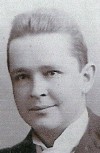
1862-1945
1889 photo
Parents
- Father: Edwin Woolley (b. about 1821, d. 27 October 1881)
- Mother: Jane Bond (b. about 1825)
Biography
- Arthur Wooley was born on 12 June 1862 in Walsall, Staffordshire, England.
- Another spelling of his name was Woolley.
- He appeared on the England Census of 33 Bath St, Walsall, Staffordshire, England, enumerated in 1871, in the household of his parents Edwin Woolley and Jane.1
- Arthur Wooley completed four years of high school.2
- He immigrated in 1881 from England.3
- In 1889 Arthur lived in Syracuse, New York, at the time of his marriage.4
- He was an opera singer.4
- Arthur married Rosella Hague, daughter of Albert Hague and Eliza Whitfield, on 12 September 1889 in Chicopee, Massachusetts.4
- They were married by Wm G Porr, clergyman.4
- In 1890 Arthur Wooley became a citizen.3
- Between August 1896 and March 1898 Arthur performed in Philadelphia with the Castle Square Opera Company, singing roles at the Grand Opera House. The operas he sang included Il Trovatore, Carmen, Fra Diavolo, Martha, Maritana, Faust, La Fille du Regiment, Pagliacci, The Bohemian Girl, Mignon and The Lily of Killarney. Within the space of 5 days, during March of 1898, he sang in 4 different operas: Il Trovatore, The Bohemian Girl, Carmen and Martha. Then, between Nov 1898 and Jan 1899 he was singing with the Southwell Opera Company, still in Philadelphia. Those roles included Maritana, Fra Diavolo and Der Freischutz. (The collection doesn't seem to include any items after 1900.)5
- He and Rosella appeared on the 1900 US Federal Census of 927 Sutter St, San Francisco, San Francisco County, California, enumerated on 7 June 1900.6
- From Sep 19th thru Oct 22 1904 Arthur performed in the original musical comedy Mr. Wix of Wickham at the Bijou Theater in New York City. There were 41 performances.7
- Arthur and Rosella lived in 26 Arlington St, Chicopee, Massachusetts.
 26 Arlington St
26 Arlington St
Chicopee, MA
home of Arthur & Rosella Wolley & family
2022 photo Arthur performed in The School Girl, a musical play, in two acts, composed by Leslie Stuart (with additional songs by Paul Rubens) with a book by Henry Hamilton and Paul M. Potter, and lyrics by Charles H. Taylor and others. It was first produced on 9 May 1903 by George Edwardes and Charles Frohman at the Prince of Wales Theatre in London where it ran for 333 performances.
I am assuming he played in the states, probably 1905. He was Tubby Bedford.8
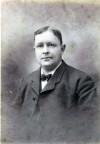 Arthur Wooley in The School Girl
Arthur Wooley in The School Girl
role: Tubby Bedford- He and Rosella appeared on the 1910 US Federal Census of 26 Arlington St, Chicopee, Hampden County, Massachusetts, enumerated on 15 April 1910.9
- He and Rosella appeared on the 1920 US Federal Census of 26 Arlington St, Chicopee, Hampden County, Massachusetts, enumerated on 19 January 1920. They own their home, free of mortgage.3
- Arthur and Rosella moved to Belmont, Massachusetts.
- In 1930 Arthur Wooley was a coach for amateur theatricals.10
- He and Rosella appeared on the 1930 US Federal Census of 6 Willow St, Belmont, Middlesex County, Massachusetts, enumerated on 14 April 1930. They own their home, reporting a value of $17,500.10
- After his wife died, his daughter Phyllis took care of him for years. She and her husband Lloyd lived with him until 1941.11
- He survived cancer.11
- He appeared on the 1940 US Federal Census of 6 Willow St, Belmont, Middlesex County, Massachusetts, enumerated in 1940. He owns the house with a reported value of $5,000. The McCabe family rented the other apartment in the house.2
- He died on 20 July 1945 in Belmont, Massachusetts, at age 83.12
- The cause of his death was hypostatic broncho pneumonia.12
- He was buried in Fairview Cemetery, Chicopee, Massachusetts. He was cremated at Mt Auburn Cemetery in Cambridge, ashes then sent to Chicopee.13
- In December 1986 the house at 6 Willow St, Belmont MA sold for #315,000. In Sep 2012 the house sold for $650,000. It is listed as a 6 bedroom, 2 bath, multiple occupancy home. In 2021 the house is estimated at $1.34 million dollars.14
Family: Rosella Hague (b. 25 March 1862, d. 6 November 1934)
- Doris Laura Wooley
 + (b. 25 August 1896, d. 7 August 1968)
+ (b. 25 August 1896, d. 7 August 1968) - Phyllis Wooley+ (b. 15 February 1899, d. June 1975)
Other Information
-
Relationship:
Great-grandfather of Linda Sargent
Great-grandfather of Julianne Stoughton - Charts/Lists: Ancestors of Barbara Lois Male, Ancestors of Jensi Stoughton, Cemeteries of Massachusetts, Male Family, Musicians, My Ancestors
- Last Edited: 19 September 2024 16:46:29
Citations
Rosella Hague

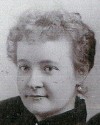
1863-1934
1889 photo
Parents
- Father: Albert Hague (b. 27 October 1840, d. 31 May 1908)
- Mother: Eliza Whitfield (b. 8 July 1846, d. 7 October 1922)
Biography
- Rosella Hague was born on 25 March 1862 in Ilion, New York.
- She appeared on the US State Census of German Flatts, Herkimer County, New York, enumerated on 26 June 1865, in the household of George Whitfield and Sarah Irlam, her grandparents, and her parents. She was listed as 2/12 years old.1
- Rosella Hague appeared on the 1870 US Federal Census of German Flatts, Herkimer County, New York, enumerated on 30 June 1870, in the household of her parents Albert Hague and Eliza. listed as Rosa.2
- Rosella Hague appeared on the 1880 US Federal Census of 6 West North St, German Flatts, Herkimer County, New York, enumerated on 2 June 1880, in the household of her parents Albert Hague and Eliza.3
- In 1889 Rosella lived in Chicopee, Massachusetts, at the time of her marriage.4
- Rosella married Arthur Wooley, son of Edwin Woolley and Jane Bond, on 12 September 1889 in Chicopee, Massachusetts.5
- They were married by Wm G Porr, clergyman.5
- Arthur Wooley and Rosella appeared on the 1900 US Federal Census of 927 Sutter St, San Francisco, San Francisco County, California, enumerated on 7 June 1900.6
- Arthur and Rosella lived in 26 Arlington St, Chicopee, Massachusetts.
 26 Arlington St
26 Arlington St
Chicopee, MA
home of Arthur & Rosella Wolley & family
2022 photo - Arthur Wooley and Rosella appeared on the 1910 US Federal Census of 26 Arlington St, Chicopee, Hampden County, Massachusetts, enumerated on 15 April 1910.7
 photo probably Spring 1919
photo probably Spring 1919- She made dresses for her grandchildren out of Liberty cotton, with matching bloomers (underpants) that showed. She was the only one who wasn't theatrical. Rosella was a lovely woman. She made a quilt of scraps of material she had sewn. She also painted - there was a painting of cows in my mother's bedroom.8,9
- Arthur Wooley and Rosella appeared on the 1920 US Federal Census of 26 Arlington St, Chicopee, Hampden County, Massachusetts, enumerated on 19 January 1920. They own their home, free of mortgage.10
- Rosella and Arthur moved to Belmont, Massachusetts.
- Arthur Wooley and Rosella appeared on the 1930 US Federal Census of 6 Willow St, Belmont, Middlesex County, Massachusetts, enumerated on 14 April 1930. They own their home, reporting a value of $17,500.11
- She died on 6 November 1934 in Belmont, Massachusetts, at age 72.
- The cause of her death was a heart attack.12
- She was buried in Fairview Cemetery, Chicopee, Massachusetts.13,14
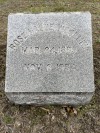 Gravestone
Gravestone
Family: Arthur Wooley (b. 12 June 1862, d. 20 July 1945)
- Doris Laura Wooley
 + (b. 25 August 1896, d. 7 August 1968)
+ (b. 25 August 1896, d. 7 August 1968) - Phyllis Wooley+ (b. 15 February 1899, d. June 1975)
Other Information
-
Relationship:
Great-grandmother of Linda Sargent
Great-grandmother of Julianne Stoughton - Charts/Lists: Ancestors of Barbara Lois Male, Ancestors of Jensi Stoughton, Cemeteries of Massachusetts, Male Family, My Ancestors
- Last Edited: 19 September 2024 16:46:29
Citations
Zipporah Elizabeth Bird

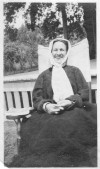
1953-1913
Parents
- Father: Matthew Bird (b. 15 September 1831, d. 1902)
- Mother: Elizabeth Williamson (b. 4 June 1833, d. 15 January 1899)
Biography
- Zipporah Elizabeth Bird was born on 29 November 1853 in Wheeling, West Virginia.1
- She appeared on the US State Census of Troy, Rensselaer County, New York, enumerated in 1855, in the household of her parents Matthew Bird and Elizabeth.2
- Zipporah Elizabeth Bird appeared on the 1860 US Federal Census of Troy, Rensselaer County, New York, enumerated in June 1860, in the household of her parents Matthew Bird and Elizabeth. Identified as Lpporah, born in Virginia.3
- Zipporah Elizabeth Bird appeared on the 1870 US Federal Census of Troy, Rensselaer County, New York, enumerated in June 1870, in the household of her parents Matthew Bird and Elizabeth.4
- Zipporah married John Male, son of Samuel Male and Louisa Mitchell, in 1871.5,6
- John and Zipporah lived in Troy, New York.
- John Male and Zipporah appeared on the 1880 US Federal Census of North Greenbush, Rensselaer County, New York, enumerated in June 1880.7
- Zipporah and John moved to Fair Haven, Connecticut, with his family around 1892.8
- In 1910 Zipporah wrote she had six children, 5 of whom were alive.5
- John Male and Zipporah appeared on the 1910 US Federal Census of 140 Exchange St, New Haven, New Haven County, Connecticut, enumerated in June 1910. They rent their home.5
- She died on 16 February 1913 in New Haven, Connecticut, at age 59.1
- She was buried in Albany Rural Cemetery, Menands, New York.9,10
 Gravestone
Gravestone
Family: John Male (b. 30 June 1846, d. 29 September 1925)
- Louise Male (b. about 1872, d. 30 March 1942)
- Emma Male (b. 22 October 1873, d. 28 April 1957)
- Isabelle Male+ (b. 20 July 1876, d. 2 February 1958)
- Edmund Stanley Male
 + (b. 30 November 1888, d. 18 September 1957)
+ (b. 30 November 1888, d. 18 September 1957) - Jessie Male+ (b. 30 January 1891, d. 6 February 1983)
Other Information
-
Relationship:
Great-grandmother of Linda Sargent
Great-grandmother of Julianne Stoughton - Charts/Lists: Ancestors of Barbara Lois Male, Ancestors of Jensi Stoughton, Male Family, My Ancestors
- Last Edited: 19 September 2024 16:46:29
Citations
John Male


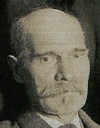
1846-1925
1910 photo
Parents
- Father: Samuel Male (b. 28 June 1804, d. 24 December 1878)
- Mother: Louisa Mitchell (b. 7 November 1806, d. 27 November 1892)
Biography
- John Male was born on 30 June 1846 in Islington, Middlesex, England+.1,2
- He appeared on the England Census of 18 Brooksby Street, Islington, Middlesex, England+, enumerated in 1851, in the household of his parents Samuel Male and Louisa.2
- John Male immigrated to America on 20 September 1869 He traveled with Frances Male, his brother, on the ship Paraguay. John's destination was Troy, Francis's was Lyon (?).3
- He appeared on the 1870 US Federal Census of Troy, Rensselaer County, New York, enumerated in June 1870, in the household of Matthew Bird and Elizabeth Williamson, he appears to board there; a shipper, born in England, age 23.4
- John married Zipporah Elizabeth Bird, daughter of Matthew Bird and Elizabeth Williamson, in 1871.5,6
- John and Zipporah lived in Troy, New York.
- John Male was a shipper.7
- He and Zipporah appeared on the 1880 US Federal Census of North Greenbush, Rensselaer County, New York, enumerated in June 1880.7
- In 1890 the City directory of Troy NY lists John as a superintendent at the Albany Iron Works, Winslow House, Mill.8
- John and Zipporah moved to Fair Haven, Connecticut, with his family around 1892.9
- John was a manager of the mill in New Haven. He was an austere man, with a beard. John and Zipporah raised Fox terriers.9
- He and Zipporah appeared on the 1910 US Federal Census of 140 Exchange St, New Haven, New Haven County, Connecticut, enumerated in June 1910. They rent their home.5
- He died on 29 September 1925 in New Haven, Connecticut, at age 79.1
- He was buried in Albany Rural Cemetery, Menands, New York.6
Family: Zipporah Elizabeth Bird (b. 29 November 1853, d. 16 February 1913)
- Louise Male (b. about 1872, d. 30 March 1942)
- Emma Male (b. 22 October 1873, d. 28 April 1957)
- Isabelle Male+ (b. 20 July 1876, d. 2 February 1958)
- Edmund Stanley Male
 + (b. 30 November 1888, d. 18 September 1957)
+ (b. 30 November 1888, d. 18 September 1957) - Jessie Male+ (b. 30 January 1891, d. 6 February 1983)
Other Information
-
Relationship:
Great-grandfather of Linda Sargent
Great-grandfather of Julianne Stoughton - Charts/Lists: Ancestors of Barbara Lois Male, Ancestors of Jensi Stoughton, Male Family, My Ancestors
- Last Edited: 19 September 2024 16:46:29
Citations
Joan Sargent



- Sargent Lineage: Richard10, Richard9, George8, Joseph7, Joseph6, Joseph5, Joseph4, Joseph3, Joseph2, John1, William0
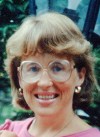
1945-1997
1994 Photo
Parents
- Father: Richard Collier Sargent, Jr (b. 5 April 1914, d. 17 April 1985)
- Mother: Barbara Lois Male (b. 21 August 1920, d. 3 March 2009)
Biography
- Joan Sargent was born on 11 July 1945 in New Haven, Connecticut.
- She moved with her parents Richard and Barbara in July 1945 to 2078 Huntington Tpke, Nichols, ConnecticutG.1
 2078 Huntington Tpke
2078 Huntington Tpke
Nichols CT
1948 photo - Joan Sargent appeared on the 1950 US Federal Census of 2078 Huntington Tpke, Other Places???????, Fairfield County, Connecticut, enumerated on 13 April 1950, in the household of her parents Richard Collier Sargent, Jr, and Barbara.2
- In May 1957 in Ridge Road, North Haven, Connecticut, Joan Sargent attended a family reunion where this photo was taken.1
 Family Reunion 1957 children of
Family Reunion 1957 children of
George Lewis Sargent
Ridge Rd, North Haven CT - She graduated from The Unquowa School, Fairfield, Connecticut, in 1963.1
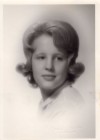 Joan Sargent
Joan Sargent
graduation from Unquow School
Fairfield, CT
1963 - She graduated from Green Mountain Junior College, Poultney, Vermont, in June 1965.1
- She graduated from University of Denver, Denver, Colorado, in 1967 with a degree in Education.1
- She graduated from Boston University, Boston, Massachusetts, in May 1970 with a Master of Education.1
- In 1971 Joan went to San Salvador to teach in a Brazilian school. She stayed one year.1
- In 1972 Joan moved to Boulder, Colorado.1
- Joan Sargent was a reading teacher in the Boulder Public School System, a Title I enrichment teacher.1
- In 1981 Joan adopted Susanna from an orphanage in Peru. She went to South America for a month to find her and bring her home to Colorado when she was almost a year old.1
- In 1986 Joan adopted Alicia from Paraguay. She went to South America shortly after Alicia's birth and brought her home to Colorado.1
- In 1992 Joan was diagnosed with breat cancer in both breasts. She came east to be treated at Mary Hitchcock Hospital in Dartmouth NH with a bone marrow transfusion, which was an experimental procedure at the time. Her cancer appeared to be in remission and she moved back to Boulder CO with her daughters, but 2 years later is reappeared.1
- In 1994 Joan moved to 5 Haskins Road, Hanover, New Hampshire, with her daughters. She was treated again at Mary Hitchcock Hospital and her daughters attended school in Hanover. She fought her battle with cancer with grace, grit and perseverence.1
- She died on 2 December 1997 in Hanover, New Hampshire, at age 52.
- The cause of her death was breast cancer.1
- She was buried in Evergreen Cemetery, New Haven, Connecticut.1
 Gravestone
Gravestone - An obituary was published.
Other Information
-
Relationship:
Sister of Linda Sargent
10th cousin 2 times removed of Kyle Lawrence Mueller
15th cousin 1 time removed of Casey Saunders Bivens
1st cousin of Julianne Stoughton - Charts/Lists: Barnum and Joan, Cemeteries of Connecticut, Descendant Chart for Elizabeth Alsop, Descendant Chart for Griffith Bowen, Descendant Chart for Thomas Trowbridge (#1), Descendant Chart for Thomas Trowbridge (#2), Descendants of JBS, Descendants of JBS (with spouses), Descendants of Nathaniel Foote and Elizabeth Deming, Descendants of Sarah Talcott & William Wadsworth, Descendants of William Sargent, Immigrant, Descent from Henry Kingsbury, Forbes Family, Kingsbury Family, Male Family, Sargent Family of New Haven
- Last Edited: 22 November 2025 14:46:40
Citations
Susanna Rosalinda Sargent



- Sargent Lineage: Joan11, Richard10, Richard9, George8, Joseph7, Joseph6, Joseph5, Joseph4, Joseph3, Joseph2, John1, William0
Parents
- Mother: Joan Sargent (b. 11 July 1945, d. 2 December 1997)
Family: Mark Edward Campbell
Other Information
-
Relationship:
Niece of Linda Sargent
11th cousin 1 time removed of Kyle Lawrence Mueller
16th cousin of Casey Saunders Bivens
1st cousin 1 time removed of Julianne Stoughton - Charts/Lists: Descendant Chart for Elizabeth Alsop, Descendant Chart for Griffith Bowen, Descendant Chart for Thomas Trowbridge (#1), Descendant Chart for Thomas Trowbridge (#2), Descendants of JBS, Descendants of JBS (with spouses), Descendants of Nathaniel Foote and Elizabeth Deming, Descendants of Sarah Talcott & William Wadsworth, Descendants of William Sargent, Immigrant, Descent from Henry Kingsbury, Forbes Family, Kingsbury Family, Male Family, Sargent Family of New Haven
- Last Edited: 27 October 2025 12:45:10
Alicia Kingsbury Sargent



- Sargent Lineage: Joan11, Richard10, Richard9, George8, Joseph7, Joseph6, Joseph5, Joseph4, Joseph3, Joseph2, John1, William0
Parents
- Mother: Joan Sargent (b. 11 July 1945, d. 2 December 1997)
Family: Joseph Cerrone
Other Information
-
Relationship:
Niece of Linda Sargent
11th cousin 1 time removed of Kyle Lawrence Mueller
16th cousin of Casey Saunders Bivens
1st cousin 1 time removed of Julianne Stoughton - Charts/Lists: Descendant Chart for Elizabeth Alsop, Descendant Chart for Griffith Bowen, Descendant Chart for Thomas Trowbridge (#1), Descendant Chart for Thomas Trowbridge (#2), Descendants of JBS, Descendants of JBS (with spouses), Descendants of Nathaniel Foote and Elizabeth Deming, Descendants of Sarah Talcott & William Wadsworth, Descendants of William Sargent, Immigrant, Descent from Henry Kingsbury, Forbes Family, Kingsbury Family, Male Family, Sargent Family of New Haven
- Last Edited: 27 October 2025 12:45:10
Richard Collier Sargent, III



- Sargent Lineage: Richard10, Richard9, George8, Joseph7, Joseph6, Joseph5, Joseph4, Joseph3, Joseph2, John1, William0
Parents
- Father: Richard Collier Sargent, Jr (b. 5 April 1914, d. 17 April 1985)
- Mother: Barbara Lois Male (b. 21 August 1920, d. 3 March 2009)
Other Information
-
Relationship:
Brother of Linda Sargent
10th cousin 2 times removed of Kyle Lawrence Mueller
15th cousin 1 time removed of Casey Saunders Bivens
1st cousin of Julianne Stoughton - Charts/Lists: Descendant Chart for Elizabeth Alsop, Descendant Chart for Griffith Bowen, Descendant Chart for Thomas Trowbridge (#1), Descendant Chart for Thomas Trowbridge (#2), Descendants of JBS, Descendants of JBS (with spouses), Descendants of Nathaniel Foote and Elizabeth Deming, Descendants of Sarah Talcott & William Wadsworth, Descendants of William Sargent, Immigrant, Descent from Henry Kingsbury, Forbes Family, Kingsbury Family, Male Family, President/General Grant and Richard Sargent, Sargent Family of New Haven
- Last Edited: 27 October 2025 12:45:10
Bonnie Mae Lincoln
Parents
- Father: Winthrop Ethan Lincoln (b. 29 May 1933, d. 10 November 2025)
- Mother: Claire Estelle MacDonald
Other Information
- Charts/Lists: Descendants of JBS (with spouses), Male Family, Sargent Family of New Haven
- Last Edited: 27 October 2025 12:45:10